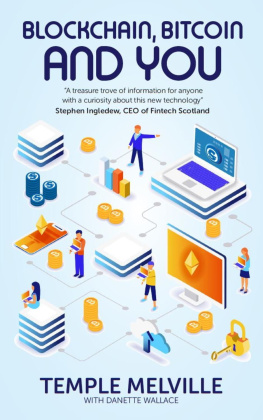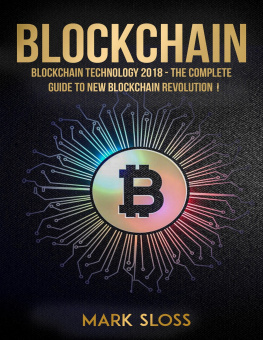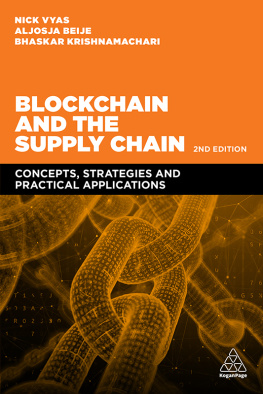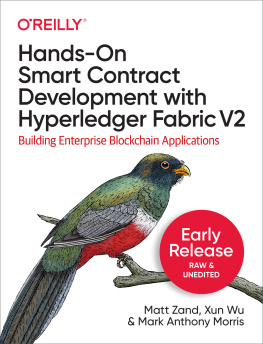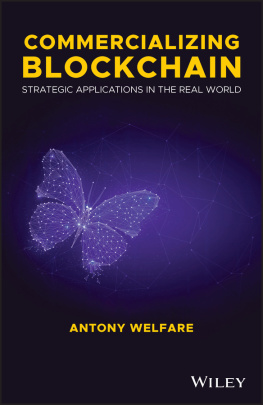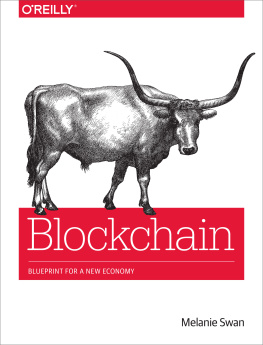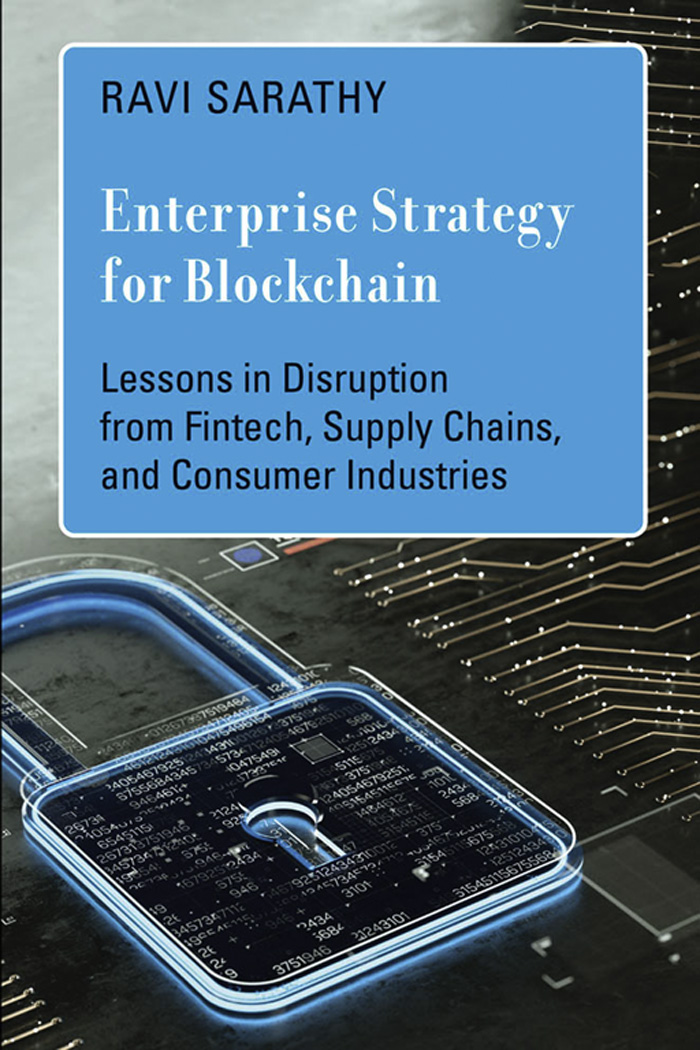
Enterprise Strategy for Blockchain
Management on the Cutting Edge series
Robert Holland, series editor
Published in cooperation with MIT Sloan Management Review
The AI Advantage: How to Put the Artificial Intelligence Revolution to Work
Thomas H. Davenport
The Technology Fallacy: How People are the Real Key to Digital Transformation
Gerald C. Kane, Anh Nguyen Phillips, Jonathan Copulsky, and Garth Andrus
Designed for Digital: How to Architect Your Business for Sustained Success
Jeanne W. Ross, Cynthia Beath, and Martin Mocker
See Sooner, Act Faster: How Vigilant Leaders Thrive in an Era of Digital Turbulence
George S. Day and Paul J. H. Schoemaker
Leading in the Digital World: How to Foster Creativity, Collaboration, and Inclusivity
Amit S. Mukherjee
The Ends Game: How Smart Companies Stop Selling Products and Start Delivering Value
Marco Bertini and Oded Koenigsberg
Open Strategy: Mastering Disruption from Outside the C-Suite
Christian Stadler, Julia Hautz, Kurt Matzler, and Stephan Friedrich von den Eichen
The Transformation Myth: Leading Your Organization through Uncertain Times
Gerald Kane, Rich Nanda, Anh Nguyen Phillips, and Jonathan Copulsky
Winning the Right Game: How to Disrupt, Defend, and Deliver in a Changing World
Ron Adner
The Digital Multinational: How to Connect and Compete in a (De)Globalized World
Satish Nambisan and Yadong Luo
Work without Jobs: How to Reboot Your Organizations Work Operating System
Ravin Jesuthasan and John W. Boudreau
The Future of Competitive Strategy: Unleashing the Power of Data and Digital Ecosystems
Mohan Subramaniam
Productive Tensions: How Every Leader Can Tackle Innovations Toughest Trade-Offs
Chris B. Bingham and Rory M. McDonald
Working with AI: Real Stories of Human-Machine Collaboration
Thomas H. Davenport and Steven M. Miller
Enterprise Strategy for Blockchain: Lessons in Disruption from Fintech, Supply Chains, and Consumer Industries
Ravi Sarathy

Enterprise Strategy for Blockchain
Lessons in Disruption from Fintech, Supply Chains, and Consumer Industries
Ravi Sarathy
The MIT Press
Cambridge, Massachusetts
London, England
2022 Massachusetts Institute of Technology
All rights reserved. No part of this book may be reproduced in any form by any electronic or mechanical means (including photocopying, recording, or information storage and retrieval) without permission in writing from the publisher.
The MIT Press would like to thank the anonymous peer reviewers who provided comments on drafts of this book. The generous work of academic experts is essential for establishing the authority and quality of our publications. We acknowledge with gratitude the contributions of these otherwise uncredited readers.
This book was set in ITC Stone Serif Std and ITC Stone Sans Std by New Best-set Typesetters Ltd.
Library of Congress Cataloging-in-Publication Data
Names: Sarathy, Ravi, author.
Title: Enterprise strategy for blockchain : lessons in disruption from fintech, supply chains, and consumer industries / Ravi Sarathy.
Description: Cambridge, Massachusetts : The MIT Press, [2022] | Series: Management on the cutting edge | Includes bibliographical references and index.
Identifiers: LCCN 2022000700 (print) | LCCN 2022000701 (ebook) | ISBN 9780262047166 (hardcover) | ISBN 9780262370851 (epub) | ISBN 9780262370868 (pdf)
Subjects: LCSH: Strategic planning. | Blockchains (Databases) | Business enterprisesTechnological innovations. | Business logisticsTechnological innovations. | FinanceTechnological innovations. | Electronic funds transfers.
Classification: LCC HD30.28 .S268 2022 (print) | LCC HD30.28 (ebook) | DDC 658.4/012dc23/eng/20220310
LC record available at https://lccn.loc.gov/2022000700
LC ebook record available at https://lccn.loc.gov/2022000701
10 9 8 7 6 5 4 3 2 1
d_r0
Contents
Series Foreword
The world does not lack for management ideas. Thousands of researchers, practitioners, and other experts produce tens of thousands of articles, books, papers, posts, and podcasts each year. But only a scant few promise to truly move the needle on practice, and fewer still dare to reach into the future of what management will become. It is this rare breed of ideameaningful to practice, grounded in evidence, and built for the futurethat we seek to present in this series.
Robert Holland
Managing Director
MIT Sloan Management Review
Preface
Books are written by reflecting and building on the wisdom and work of other scholars, and this book is no different. I have benefited enormously from reading and following the writings and opinions of a large number of blockchain researchers and entrepreneurs. Blockchain has been sometimes referred to as the bedrock on which Web 3.0 will be built, a new version of the internet that draws on decentralized peer-to-peer interaction. For many, cryptocurrency is the starting point for their voyage into the intricacies of blockchain. And although blockchain has been extensively deployed in gestating Bitcoin and other cryptocurrencies, I highlight the extensive application potential of blockchain and the underlying distributed ledger technology for enterprises and across society.
Blockchain is a fast-changing field at a stage where there are new developments every week, and as I researched and wrote this book, I was constantly rewriting to reflect this continually morphing space. Hence, writing this bookand reading itis the beginning of a journey. I hope this book stimulates your interest and leaves you wanting to learn more.
My thanks to Emily Taber, Acquisitions Editor at the MIT Press, for her thoughtful assessments, her continuing involvement, and encouragement in the writing of this book. My thanks to the several anonymous reviewers who took the time to offer insightful comments on draft versions of this book. Thanks to Abigail Holstein, development editor, who wrestled with and competently clarified my draft manuscript, and to David Weinberger, who offered perceptive comments on the introduction. I want to thank the DAmore-McKim School of Business at Northeastern University and Acting Dean Emery Trahan for creating a supportive environment during the research and writing phases. And a special thanks to my wife Beth for her patience and support during the long period I was wrapped up in researching and writing this manuscript.
Introduction: Blockchains Disruptive Potential
In 2021, a group of hackers broke into a computer system containing software applications governing pipeline operations at the Colonial Pipeline Company. They encrypted data and locked access to the system critical to the pipelines functioning and demanded ransom payments to release the data. And in addition to paying the ransom, the company had to contend with lost revenue and reputational damage.
Whether for a pipeline or a financial institution, it is essential for a company to protect itself and its operations and databases against adversarial, ill-intentioned economic actors. A solution lies in distributed ledger technology (DLT), popularly referred to as blockchain. DLT was designed with the assumption that firms will be faced with untrustworthy counterparties who will attempt to exploit online transactions for private gain. In the case of Colonial, with its use of sensors, valves, and leak detection systems in controlling its pipelines, blockchain-based multitier cybersecurity protection in a smart metering environment could have provided protection.
Next page

